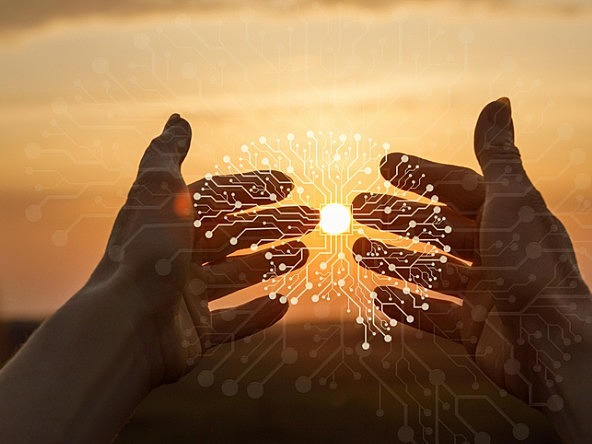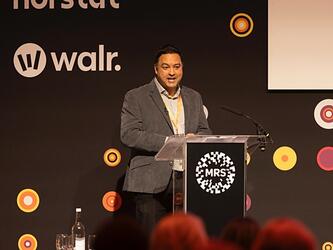Breaking free from algorithmic loops

In an era where AI increasingly infiltrates decision-making, there’s a tendency to assume that complex cultural analysis can be outsourced to machines. Industries seek efficiency, turning to AI for trend forecasting, art curation and societal sense-making. But can something that does not live within culture truly interpret it?
Not exactly. Without a human-led interpretive framework, AI risks reinforcing biases rather than fostering innovation. To break free from algorithmic loops, researchers and analysts must move toward living foresight models, approaches that integrate AI’s strengths with human critical thinking to interpret cultural complexity in real time.
The danger of misreading how the human component interfaces with AI will continue the repetitive cycle of trends, much like we have seen since Y2K.
Consider the Coldplay Effect: while AI didn’t create Coldplay, algorithmic recommendation systems reinforced a feedback loop where creativity became predictability. And, to think, it happened without explicit AI, just by building in the power of a transactional world, one in which its inhabitants strive for acceptance and fear failure.
Now, in an age of information overload, where “everything everywhere all at once” (to cite the 2022 absurdist comedy-drama) demands our attention, our systems are designed to streamline, categorise and prioritise what is most clickable, profitable or familiar. This raises concerns about AI’s potential to dilute critical thinking.
However, human-machine interaction is reciprocal. AI doesn’t inherently diminish critical thinking — it depends on whether it’s used passively or as a tool for deeper inquiry. AI enhances reasoning, scales datasets, and identifies patterns. More importantly, it can help address its biases and our own.
Our work in applied semiotics began in 2001, mapping cultural patterns using foundational NLP and machine learning. Early on, we recognised that traditional demographic models of millennials weren’t holding as conditions changed. Our mapping method allowed us to connect patterns across cultural contexts, revealing that meaning isn’t static but shaped by perception, lived experience and shifting narratives.
Because language encodes culture, it’s a critical entry point into AI-human interaction. AI can process large datasets, but the interpretive lens, the ability to ask the right questions, remains a human strength.
In 2023, Matt Klein, author of ZINE, a publication examining social change, invited us to analyse trend trajectories for his META reports dating back to 2018. The collaboration merged his hybrid human/AI trend aggregation with our cultural framework, refining data through a social science lens. In updating the data for 2025, we confirmed Matt’s sobering hypothesis: despite technological advancement, cultural shifts were reinforcing dominant structures rather than disrupting them.
Matt’s process aggregates trend descriptions, using AI to extract representative keywords, refine them into a portfolio and analyse multiple data sources, such as news, social media and finance, to quantify trend growth. AI then clusters findings to distill broader patterns.
Yet, data alone doesn’t equate to meaning. Clustering categorises information into fixed groups, useful for topic analysis but restrictive for tracking cultural evolution. Language, by contrast, is fluid. Without a guiding framework, clustering reinforces patterns rather than interpreting why they matter. This is where our culture mapping method applies as a living foresight model that contextualises trends beyond static categories.
We expanded Matt’s analysis by using AI to map linguistic patterns along an analytic/expressive x-axis and a static/progressive y-axis, determining whether trends were disruptive, emerging, dominant or residual. This revealed not just the trends themselves, but their trajectories. Computational linguistics helped us track these signifying markers, identifying forces driving shifts beyond what data alone could surface.
AI also allowed us to revisit our own cultural reportage from 2004 to 2006. As we suspected, today’s trends echo patterns from nearly two decades ago. Using AI, we projected trajectories to 2032, confirming that, if we keep on the same path, many cultural shifts will remain static, reinforcing dominant norms rather than reshaping them.
Society now stands at a crossroads, where institutional collapse and digital reinvention define the next decade. Emerging trends, such as DIY economies, AI trust crises and gamified cities, suggest decentralisation and user-driven power structures. But these shifts teeter between empowerment and exploitation. The future depends on ethical frameworks ensuring innovation fosters resilience rather than deepening socio-economic divides.
As AI-driven decision-making expands, control over cultural narratives must be questioned. Over-reliance on AI risks homogenising creative landscapes and centralising power within opaque systems. Knowing this should light a fire under analysts and organisations to critically interrogate data rather than passively accept it, defying the hypernormalisation of our time.
To ensure AI enhances rather than replaces cultural analysis, it must be treated as a tool, not a decision-maker. While AI processes vast amounts of data, only human interpretation can uncover deeper cultural meaning. Analysts must remain active participants, questioning AI-generated insights and integrating human-led frameworks like semiotics to bring nuance and context to surfaced data.
The fault doesn’t lie solely with AI. Analysts often over-trust data’s quantitative presence, assuming numbers alone offer truth. This blind acceptance fuels cycles of repetition, creating a false sense of security. The real issue isn’t AI’s bias. The real issue is the tendency to accept given insights rather than seeking what’s missing. The solution is a hybrid approach: leveraging AI’s strengths while maintaining human critical thinking at its core.
Ultimately, the question of AI in contrast to human comes down to what makes a good analyst. What distinguishes a good analyst is self-awareness, relentless curiosity, and the ability to probe and navigate complexity, to connect disparate ideas. AI can recognise patterns at scale, but it lacks the lived experience, emotional depth and critical reasoning necessary to interpret context and challenge assumptions. The best insights emerge from collaboration, where AI’s processing power meets human intuition.
While AI can support analysis by surfacing trends and organising information, it cannot replace the human instinct to ask how it influences behaviour. The future of cultural analysis depends on those willing to push beyond pre-programmed insights. It requires analysts who challenge, reinterpret and shape narratives AI attempts to quantify, ensuring cultural analysis remains dynamic and deeply meaningful.
Marie Lena Tupot and Tim Stock are co-founders of ScenarioDNA

We hope you enjoyed this article.
Research Live is published by MRS.
The Market Research Society (MRS) exists to promote and protect the research sector, showcasing how research delivers impact for businesses and government.
Members of MRS enjoy many benefits including tailoured policy guidance, discounts on training and conferences, and access to member-only content.
For example, there's an archive of winning case studies from over a decade of MRS Awards.
Find out more about the benefits of joining MRS here.














0 Comments